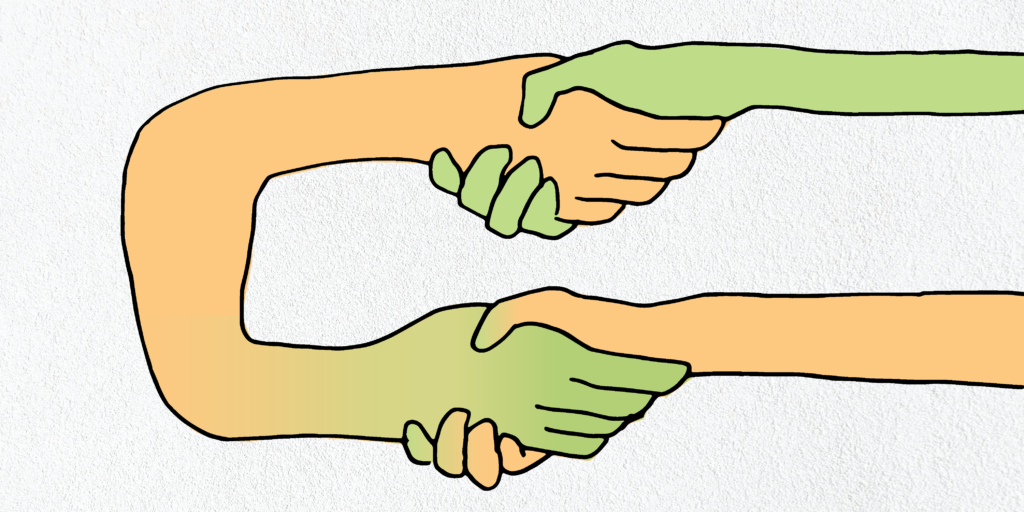Black holes are prisons of light. They are both metaphor and physical entity, mute commentary on what is known, unknown, and unknowable. Well-studied but poorly understood, like a virus.
What happens gravitationally if you squeeze the mass of an object to a point? This was Karl Schwarzschild’s question while stationed at the Russian front of the First World War. You get a point of no volume and infinite density — a singularity. It would be surrounded by a region where nothing, not even light, could escape. This boundary became known as the event horizon because no event within the boundary could be observed from outside.
If there was a boundary around Wuhan, where the coronavirus originated, it was porous. Before the city was locked down on January 23, near the beginning of the 16-day Chinese New Year celebrations, the mayor estimated that five million people left. By the time I start tracking it at the beginning of March, red dots appear like sparks all over the globe. One by one the sparks become fires, new hotspots. The virus was on my periphery till then — something that barely registered in my universe.
Schwarzschild sent his solution in a letter to Einstein in 1916: “As you can see, the war treated me kindly enough in spite of the heavy gunfire, to allow me to get away from it all, and take this walk in your land of ideas.”
•
Early in the semester, before ever hearing of Wuhan, I told my astronomy class that when Cambridge University closed due to an outbreak of the plague in 1665, Isaac Newton went home to Lincolnshire and over the next eighteen months developed his theories of calculus, optics, and gravitation. Or so he recalled later in life. The Annus Mirabilis, Miracle Year, though historians argue that the work was spread over half a decade. I joked that if they invented a branch of mathematics to solve their homework, I would give them an A.
My university shifts to online classes in the middle of March and the nebulous threat crystallize into reality. Walking home after the announcement, I feel unease, like waiting for an ill wind to pass through — the sort of miasma that Londoners thought was responsible for the plague of 1665 — and only when it is gone will we know who it has claimed and who it has left behind. The virus has already infected people in 122 countries.
Einstein’s first test of his theory was the precession of the orbit of Mercury, a 200-year-old anomaly of Newton’s laws. So close to the sun, Mercury doesn’t skate over the same ellipse every orbit like the other planets but spirals around instead because of how the sun curves spacetime. It will complete a rosette pattern, with 12 million overlapping lobes, in three million years. Einstein wrote a friend about his delight at getting the right answer: “I was beside myself with joy and happiness for days.”
Curved spacetime: was there ever a more elegant idea?
Einstein to another friend in 1915: “The theory is beautiful beyond comparison.”
•
In the first days of social isolation my mind races to worst-case scenarios. All I can do is wait: for it to get worse, to hear of the stock market collapsing, of the breakdown of society, to hear it has hit home — touched my parents, or my sister. I talk about life in the universe and the future of humanity with my classes; it’s not a nuclear war that we should be concerned about, I tell them, but a virus — the same way that it was bacteria that killed the Martians in War of the Worlds. Despite the recent outbreaks of SARS, MERS, swine flu, and Zika, I thought it was still in the future – all this fear and disease and death. Yet here it is now, spreading, truly, like the plague.
The expression “avoid like the plague” dates back to the fifth century when Saint Jerome wrote, “Avoid, as you would the plague, a clergyman who is also a man of business.” The rules for social isolation are to stay home, avoid touching your face, and wash your hands with soap because soap will pull the virus apart.
A few days after we shift to online classes, the university closes the dorms and sends the students home. Later I find out that this is six weeks after Boston had its first case on February 1: a student who came down with symptoms after returning from Wuhan. He went into self-quarantine.
Quarantine: from the Italian quaranta giorni, meaning 40 days. When ships arrived in Venice during the 14th-century plague epidemic, they were required to anchor off the coast for 40 days.
I text my sister, Terrie, who has battled melanoma for years and had a procedure to help her breathe last August, with concerns about isolation. She has been in her own quarantine for six months already and replies that she’s used to being careful around colds and flues and hopes it will blow over soon.
In the evenings, I track the infection rates and deaths on multiple websites. On March 19, global deaths hit ten thousand. Italy surpasses China in number of deaths with more than three thousand. My hand goes over my mouth. “Oh my god, Italy,” I say under my breath. Every night the numbers surge relentlessly upwards.
I watch a video of an Italian man looking through the obituaries of his newspaper in Bergamo. In early February they spanned just a page and a half, but now, in the middle of March, they go on for ten pages. You can hear him counting the pages as he turns them. Friends who have relatives in Italy tell me how overworked and stressed the health-care workers are there, how thin the resources have been stretched. They suggest we are about two weeks behind Italy.
In my online lectures, there is little back and forth with the students — as if they are in shock — and most days I feel like I’m talking into a black hole.
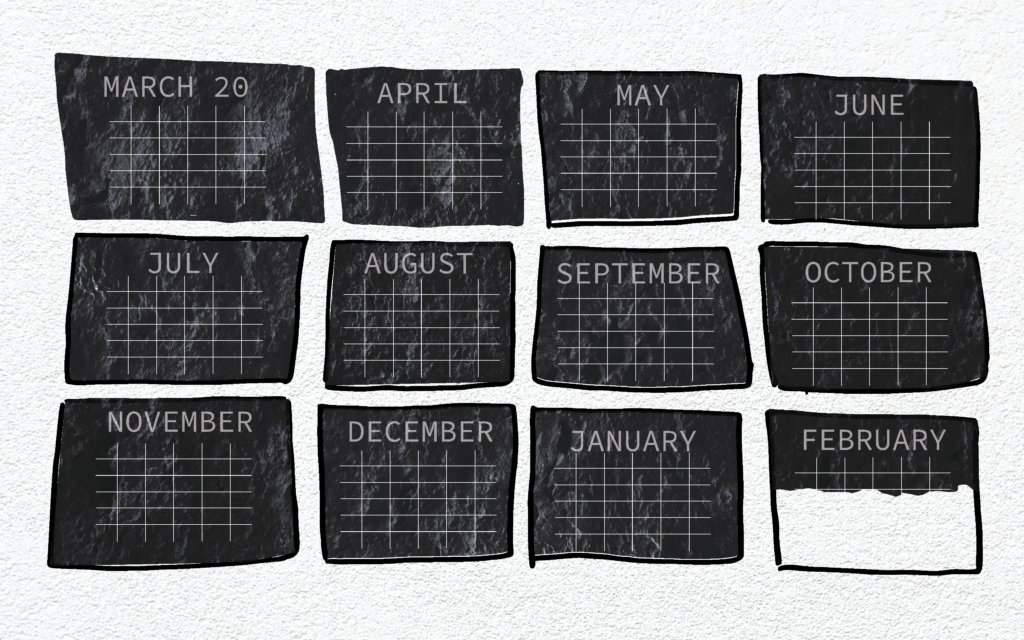
Schwarzschild’s result was ignored until physicists began to think about the fate of massive stars. With nothing to support them when they exhausted the fuel in their cores, they would fall in on themselves and become gravitationally completely collapsed objects. Such a name was too unwieldy and ultimately they became known as black holes.
Coronaviruses are surrounded by club-like protein spikes that give them the appearance of a solar corona — hence their name. They are parasitic and rely on host cells to copy their genomes.
Because they are not cellular, and can’t replicate on their own, they have no place on the tree of life. They are not alive. But they may originate with the first cells, or even predate them. Rather than branching off the tree of life, perhaps they snake through it.
I watch a cell-phone video of Italian police singing in the street to boost the morale of the homebound citizens, another of Italian mayors swearing at anyone defying stay-at-home orders.
I join an International Poetry Circle on Twitter, started by Tara Skurtu, who writes, “This unprecedented time of social distancing is a very lonely one.” She invites others to contribute a reading of a favorite poem. I default to Mary Oliver’s “Wild Geese,” which has the lines, “Tell me about despair, yours, and I will tell you mine. / Meanwhile the world goes on.” Someone comments, “I don’t know how you read that poem without sobbing.” The world goes on, askew.
•
My first trip to the grocery store during the era of social isolation is a visit to dystopia. One-third of the shoppers are wearing masks, but everyone is skittish, keeping their distance, avoiding eye contact, looking at one another with suspicion, wondering who might be carrying the virus.
Four Boston hospitals report that 345 of their health care workers have already tested positive for the virus.
The whole world is radioactive.
By the time I lecture about black holes at the end of March, we have already been isolating for two weeks in an effort to “flatten the curve.” If coronavirus cases rise exponentially they will overwhelm the medical system and many people will die. If instead, we reduce transmission by staying home, new cases will drop – the curve will “flatten” – and many lives will be saved.
•
Black holes are all curve, bottomless pits in spacetime.
How do you find an isolated black hole? How do you photograph what you can’t see? How do you kill a virus when it is not even alive?
Wild Geese: “Whoever you are, no matter how lonely.”
When people hear about black holes they always want to know what happens when you fall into one as if they are portals to other dimensions or other universes. One can’t get close to stars because of the intense heat, but because black holes don’t radiate, a curious astronaut could tempt their fate by traveling close to one, even too close.
•
The coronavirus is about 100 nanometers across, visible only in electron microscopes. If you come too close to an infected person — within six feet — the virus can be transferred to you through the air. After you inhale it, like a compact ball of connivance, the virus latches spiky surface proteins to healthy cell receptors, especially in the lungs, and forces its way inside. There it hijacks the cell’s protein-making machinery to translate its RNA into new copies of the virus. When the virus kills the cell, its copies escape and infect other cells.
The technical name is SARS-CoV-2 for “Severe Acute Respiratory Syndrome Coronavirus-2,” which causes the respiratory illness “Coronavirus Disease 2019” (COVID-19). Once in the lungs, the virus causes inflammation that fills the ends of the lung branches with fluid, preventing them from oxygenating the blood. The patient begins to drown. At this point, the patient needs a ventilator until the inflammation diminishes and they can breathe on their own again.
•
In the midst of the coronavirus outbreak, I’m excited about the trip to the “land of ideas,” and welcome the respite from the existential pall that grips the world. I show my students two videos about falling into a black hole. The first is an extended analogy at a waterfall that describes how light, traveling upstream can’t overcome the flowing of space into the black hole. “Space! This stuff!” the narrator says as he holds his hands a foot apart, “is flowing at the speed of light.” I watch this video every semester and each time I marvel at that incredible statement.
A black hole is a waterfall of space.
The analogy breaks down at the singularity in the same way our equations do. The event horizon that surrounds the singularity is like the veil of unknowing. Light can’t escape so the inside is hidden away, unknowable.
A second video mentions a zone just beyond the event horizon where the space is so curved that a photon can orbit — like a marble in the rim of a funnel. A perpetual ring of light, a snake eating its tail.
•
There are few rings of light in the cosmos. The halo that sometimes forms around the sun or moon is more of a glow than a shining ring. In Wyoming for the total solar eclipse three years ago, like millions of other people on the path, I saw day become night as the moon completely blocked the sun and the sun’s corona blazed out in a dazzling ring of light.
In this pitch-black world, there is only a little pinch of light.
When Einstein replied to Schwarzschild, he stressed the importance of another test of his theory – to observe the deflection of starlight during an eclipse. After it was finally verified in 1919, the New York Times trumpeted the news:
Light All Askew in the Heavens
•
Men of Science More or Less Agog
Over Results of Eclipse Expeditions
•
Einstein’s Theory Triumphs
•
A feeling of melancholy takes me: leadership eclipsed, the failure to protect doctors and nurses with the proper equipment, patients in intensive care who can’t have visitors, patients who die without a loved one by their side.
I remember going to visit my sister for Canadian Thanksgiving last October. We went for a walk to admire the larch trees that turn yellow and drop their needles in the fall. I don’t remember if she brought her oxygen with her or not. On the way back, I asked her how she was — she had just spent three weeks in the hospital. I was taken aback by the simplicity of her answer. “Oh, fine,” she said, “it’s good to be out on such a beautiful day.”
Back at her place there were frequent lulls in the conversation and I felt a heavy space between us. She asked me about my future travel plans and I couldn’t reciprocate because we both knew how sick she was. How do you talk to the dying? I asked myself again and again.
I contribute another poem to the International Poetry Circle, a reading of Li Bai’s “Taking Leave of a Friend,” with the lines, “We say goodbye, this is where we part.// Your horse winnies once, twice. You ride away.”
Orange body bags in a corridor of a New York hospital wait to be carried away.
The earth turns white, the moon is being interred
the funeral drags on forever.
•
If you fall into a black hole, you won’t notice that you’ve crossed the event horizon and you will think your time is passing normally. Someone who watches you will think your time is passing more slowly. They will see you frozen at the edge of the black hole. You will see all the light of the universe falling into the black hole as you are stretched like spaghetti.
There’s a word for that: spaghettification.
There is no word for the strange passing of time or the strangeness of life during a pandemic. The word I keep hearing: surreal.
A black hole is warped spacetime.
If you get the coronavirus, you may not know it at all, and unknowingly pass it on to others. You could get the symptoms that come with respiratory illnesses: coughs, sneezing, and fever. You could recover quickly. Or you could have to go to the hospital because your immune system is overwhelmed. Because you have the virus, you can’t have visitors. The only people who see you are doctors and nurses. They are your connection to the world. You could need a ventilator. You could still recover. Or you could die.
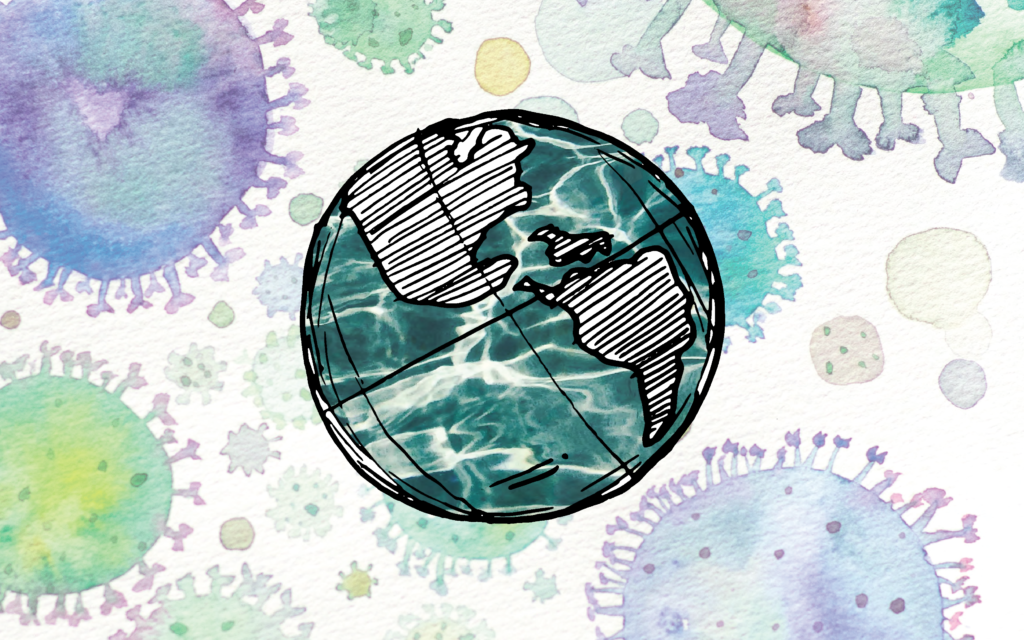
I loop back to the photo I took of my sister and me at the larch trees — an arm’s length selfie. Though the larches were on fine display behind us, what strikes me are the differences between our expressions. I have a grin big enough to make my eyes squint as if one of us just cracked a joke, and she is not quite smiling: her mouth is closed and flat as she gazes straight at the lens. Our spacetime trajectories were completely different to arrive there together and in her expression I see someone who has been staring into a black hole.
•
A friend writes on her social media: Go out and look at the beautiful night sky. Out to my deck, I go and the entire universe is waiting. Orion high in the south with Sirius tagging along, the slim crescent moon to the west below a brilliant Venus. The faint Pleiades and red Aldebaran, the eye of Taurus, in between. I wonder when I last looked at the night sky. Months, perhaps. Like almost everyone else, my life was inside, in front of a screen. Here was the universe as I remembered it, expansive, gleaming, and full of silence.
The moon hung above the trees. I’ve been reading a book of poems by Tom Sexton who kept thinking about the ancient Chinese poets — and it’s hard not to. They loved the moon and it floats through their poems like a gull on the wind.
If the moon became a black hole, it would be no bigger than the period at the end of this sentence.
I text my five siblings who are two time zones and half a dozen borders away to look too. They respond with jokes and gifs about clouds and nebulae, and the act of looking becomes not just a shared moment of connection, but a shared joke as well. From her responses, I can’t tell if Terrie went out to look — she had to conserve energy and was most often found in her living room reclining in her leather chair, linked to her oxygen tank – but she chimes in with laughter at the jokes.
On the night the moon waxes to full I wander from room to room to watch it rise above my neighbor’s house, through the trees, into my windows. I turn out the lights to see it light up the walls and floor beyond the windows. I’m transfixed by its glow, desperate for transcendence. Once it is high in the sky I go out to my deck and notice it has a brilliant halo.
By early April the number of new cases in the US continues to rise, and the US surpasses Italy as the country with the most deaths. But a week later there are signs the curve is flattening. I watch a video of doctors and nurses cheering when a patient is released from the hospital.
•
A third video I show is about the Event Horizon Telescope and how it will try to directly image a black hole. Though the image came out last year, the video is still good background. It’s heady stuff how they linked up several radio telescopes to turn the entire planet into a giant radio dish. Though the accumulated circumstantial evidence for black holes is now impressive, directly imaging one will be a fantastic achievement. The video quotes a scientist who says, “We have no idea what we’re going to see,” and I think, Really? Don’t you expect to see glowing matter swirling around a dark hole? Don’t we all know that?
Black holes have always been about mystery.
Perhaps he meant that because of the strongly curved space, the bending of light, the beaming and Doppler shifting, the unknown magnetic fields, and the presence of jets and an accretion disk, it was hard to predict what the image would look like.
When the image was released a year ago, I didn’t understand it at the time, but I was fired up about it: a fuzzy ring of light surrounding a black region.
After the lecture, a friend sends me a New York Times article about a terrific new paper that analyzes the black hole image. The scientists show that contained within the blurry image is all the light in the universe that fell on the black hole. I hang on the line, “You can see the whole universe,” as if it’s a magic spell. An accompanying animation shows photons being deflected as they approach the curved space of the black hole. Some photons loop halfway around the hole and fly out the direction they came while others zing all the way around and fly out toward us. Finally, the animation shows a shower of photons that fall on the black hole from every direction — all the light in the universe — and we see how each rings around the black hole and contributes to the final image.
•
One coronavirus survivor says he got caught in an anxiety loop. He was anxious because he had COVID-19, and the anxiety made him short of breath. And that made him anxious so he felt more shortness of breath. Then he had a small panic attack because he thought he was going to suffocate. Until his wife scratched his back and he began to calm down.
My sister went into the hospital last August because tumors were growing in her esophagus and she had trouble breathing. She was put on a ventilator and we keyed into her oxygen counts. It was something new to ask her about: “How are you today? How’s your oxygen?”
My mind lights up upon seeing the animation, the coronae. With a larger telescope — an additional telescope in space or on the moon — we would see rings within rings, each one an image of the universe.
Day after day, I put meditation music on infinite loop to try to stay calm. I take a few deep breaths. It works for an hour or two until the loop repeats one too many times and I change it.
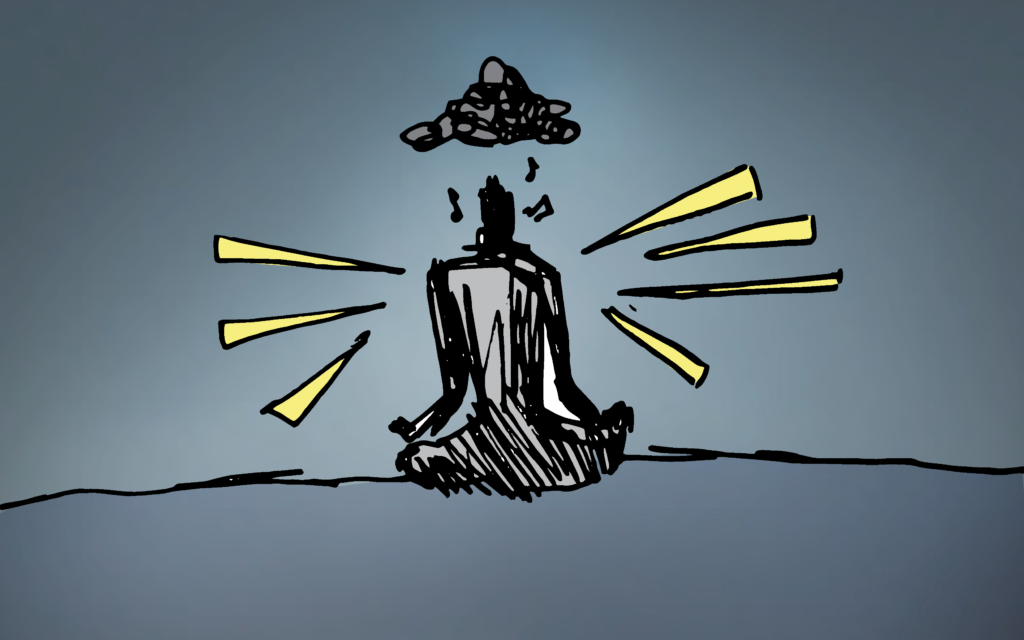
The animation indicates the ring is embedded in the blurry image, like a kernel of truth that must be extracted.
I make a short video to narrate the animation and share it on social media. I show it virtually to friends and treat it like the discovery of the year. In the video, I laud the New York Times headline: “Infinite Visions Were Hiding in the First Black Hole Image’s Rings.”
To image the black hole at the heart of the galaxy M87, the entire Earth was turned into a giant telescope.
Coronavirus has turned the population of 7.8 billion humans into potential hosts.
Two days later I show the animation to my astronomy students. I think it’s even exciting enough — and people are stressed enough — that I show it to my math classes and physics seminars later in the week. One student chimes in on chat with the reaction I was hoping for: Very cool!
•
A few nights after my black holes lectures, I pick up the volume, “Something Crosses My Mind,” by the Chinese poet, Wang Xiaoni, and catch on the line:
All the light in the universe collects here.
All the light of the universe rings around a black hole. Some of it flies toward us; some of it falls in and is lost forever.
She is not writing about black holes, of course, but about a sunbeam at the end of a long corridor.
There is only me, leaning on the sunlight,
stopping for ten seconds.
Ten seconds can be as long
as a quarter century!
The days accordion out; the weeks flit by.
Perhaps my sister was walking down her own long corridor, and though Death had opened a door for her, she refused to go through. Maybe the long corridor curled around so that she stayed in a holding pattern, a steady orbit close to the edge.
I find out Wang Xiaoni, retired from Hainan University, is being investigated by the university for supporting another academic on social media who was critical of the government’s response during the pandemic.
I learn from my younger brother that my sister is lifting her quarantine. She awoke with “a weight on her chest” and had trouble breathing. Though she was able to acquire some medication and overcome the crisis, her orbit seems ever more precarious. When I ask her how she is, she keeps it light, says she slept well because she was so tired, that her energy is okay.
The nature of black holes is patiently teased out of equations and astronomical observations. The narrative of coronavirus, whether in China or the US, is subject to censorship and misinformation, to politics and ego. To my surprise, friends of mine now circulate conspiracy theories.
•
The name black hole was inspired by the Black Hole of Calcutta, a prison where many British soldiers died of suffocation on June 20, 1756. The true number is disputed by historians because there was only one eye witness report and no corroboration. Nevertheless, it gained infamy as a place where prisoners went in but didn’t come out.
Black holes are prisons of light.
Physicist Robert Dicke did theoretical work on black holes in the early 1960s. According to his children, whenever something got lost at their house, he would say, “Ah, it must have been sucked into the Black Hole of Calcutta.” Though he first used the name in colloquia, his colleague, John Wheeler, still gets the credit for naming black holes.
A patient who has battled the virus for two months writes, “I felt imprisoned within my body, imprisoned within my home . . . I feel incredibly alone.”
I think about a poem I wrote about Valentin Lebedev who spent seven months in space, the ultimate in social isolation: “After five months, I wept with homesickness.”
One of the many strange things of the pandemic is that it worsens as spring progresses. My street is a riot of color and a mat of phlox in my front yard bursts into myriad blossoms. I send a photo to my sister by way of checking up on her. She replies: “Having a low key day. I like your phlox.”
A weekly Zoom drink with my family — siblings, parents, nieces and nephews, all eighteen of us — gives me some much-needed moments of levity, but I don’t remember the last time someone touched me.
Every day I am home, alone.
•
What have I lost? A presentation at a nature center, a reading. A writing residency in Belgrade, a hiking excursion in the Balkans. Patience. Focus. Connection to the “outside” world. The ability to plan ahead.
Black holes have an escape velocity that exceeds the speed of light. How do you escape the coronavirus when it is everywhere?
Another week passes, I am biding my time, stuck in an orbit around a black hole. Is today the day I succumb, perhaps from a visit to the grocery store, or by touching an infected door handle at my building’s entrance?
Nurses appear on social media in tears, and plead for us all to stay home. The videos go viral.
A friend begins her online journal entries: “Day Whatever of COVID-19 pandemic.”
Some days I’m trapped inside my event horizon and can’t call out. Other days I just pick up the phone and call someone, anyone.
The last time I video chat with my sister she is weak and complains of shortness of breath. I fear the worst when two days later she says she wants to go to the hospice.
•
Most, if not all, galaxies have a black hole at their centers and their role in galaxy formation and evolution is not yet understood. Though the black hole at the center of the Milky Way, called Sagittarius A*, contains four million solar masses, it is such a steep, compact hole that if it were at the sun’s position the event horizon would be well within the orbit of Mercury.
In mid-April, astronomers announce the star S2 is found to complete a rosette pattern around Sagittarius A* in accordance with Einstein’s theory. It will finish the pattern in 28,800 years with 1800 lobes. The petals of a cosmic flower now being traced out.
Black holes are the largest single structures in the universe and will outlive all the stars. As if a tapestry is survived by its holes. All the light of the universe will one day fall into a black hole. They do evaporate but the time scale is so ridiculously long they should be considered almost permanent.
When two black holes collide they send gravitational waves into the universe. The first wave of coronavirus has yet to subside — how long before the second wave hits? Do we now live in a coronavirus world?
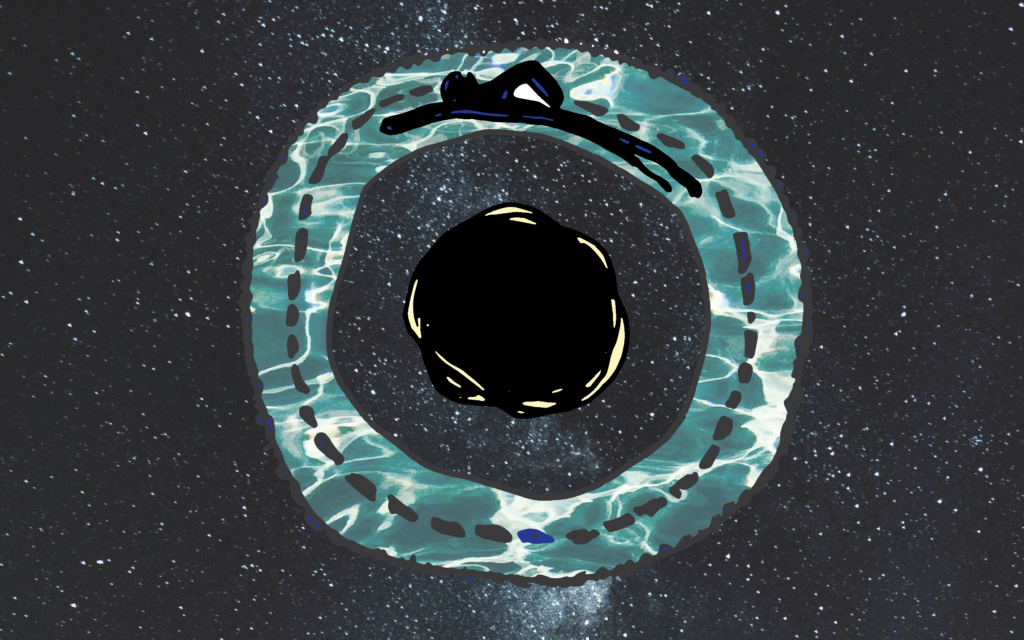
The coronavirus can survive for up to three days on plastic and stainless steel surfaces, less than four hours on copper, and less than 24 hours on cardboard.
A black hole has no surface.
I have to hold my breath when I check the numbers. The mortality rate among Black people is twice that of whites and Latinos. By the end of May, the US surpasses 100,000 coronavirus deaths.
Because of COVID-19 travel restrictions, I’m unable to visit my sister now. In the hospice there are strict rules for visitors: gowns must be worn, as well as gloves, masks, and face shields. She would barely know who came to see her — except for the eyes. I get reports late in the afternoon that her breathing is shallow. The next morning, I receive the sad news.
When I find out, a black hole instantly opens in my life.
•
I’ve long thought of the sensitive letter Einstein sent to the Besso family after the passing of his lifelong friend and confidante, Michele:
Now he has departed from this strange world a little ahead of me. That signifies nothing. For us believing physicists, the distinction between past, present, and future is only a stubbornly persistent illusion.
Two weeks after my sister and I went to visit the larch trees I texted her to find out if they were still radiant yellow. She replied that the last time she was there many needles had fallen. Then she sent two photos: the first showed the mostly barren larch trees, their brilliance gone, now bracing for winter; and in the second photo, a few larch branches forked out of a vase beside the fireplace in her living room, as if a fragment could stand-in for the whole.
I remember that yellow was her favorite color
Where is the surface of grief?
Another poem for the International Poetry Circle — a request for Szymborska. I have to record the poem twice because I get stuck on the line, “How gently the world touches me.” •
